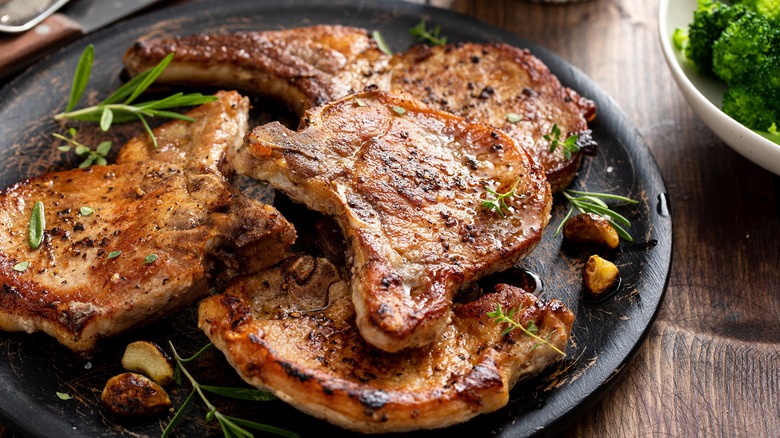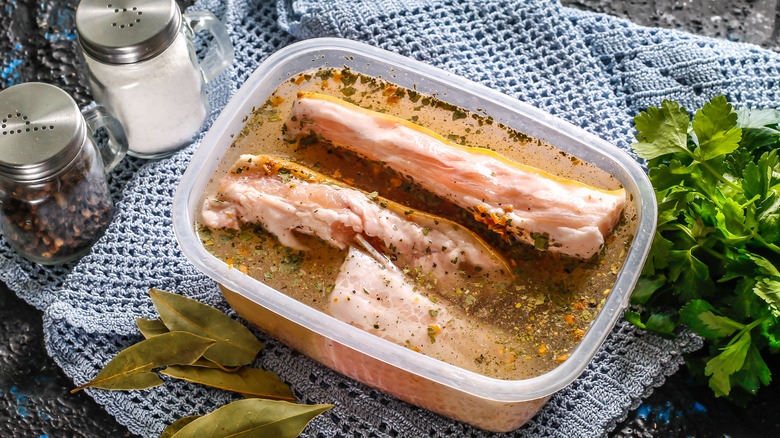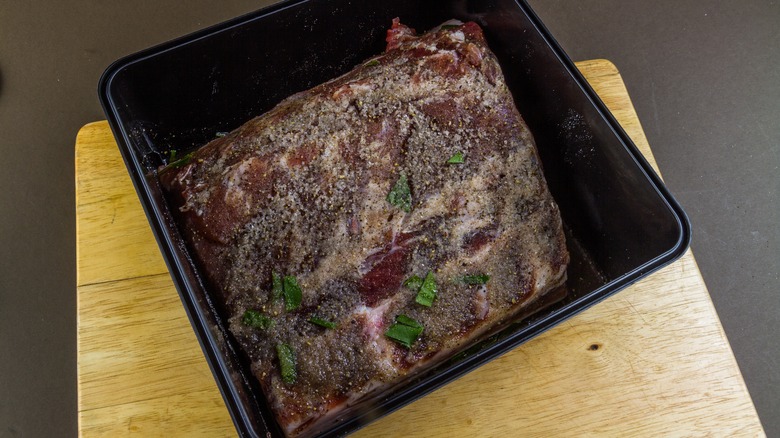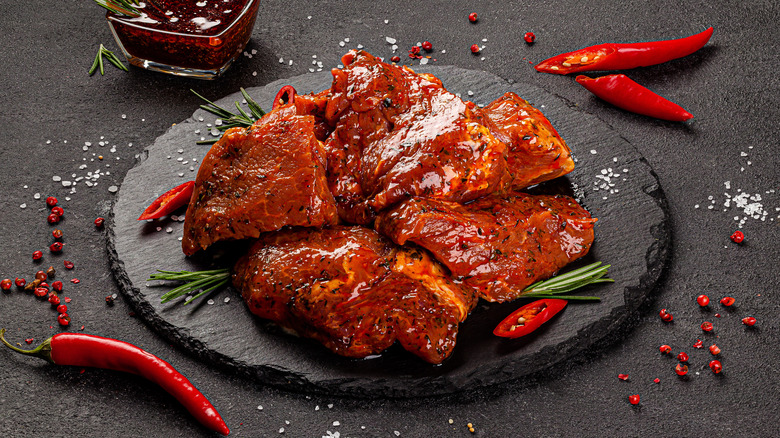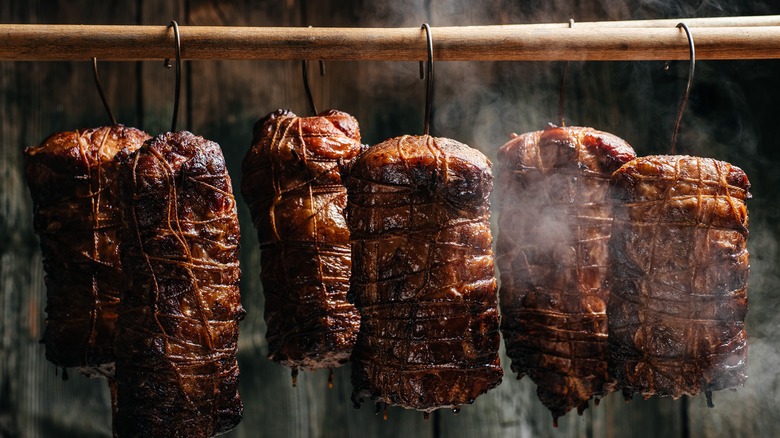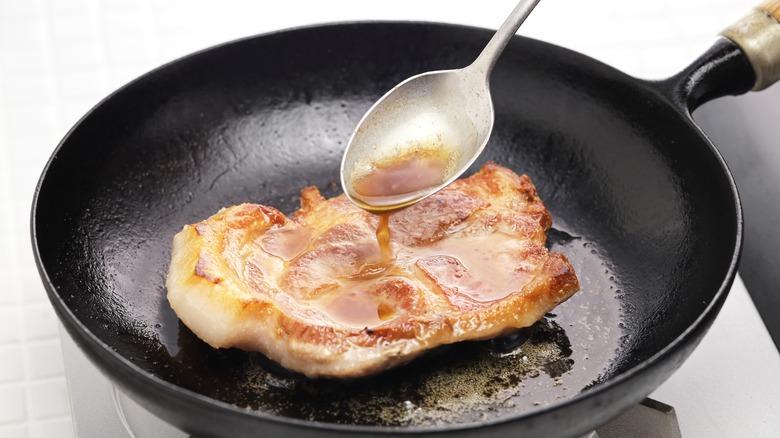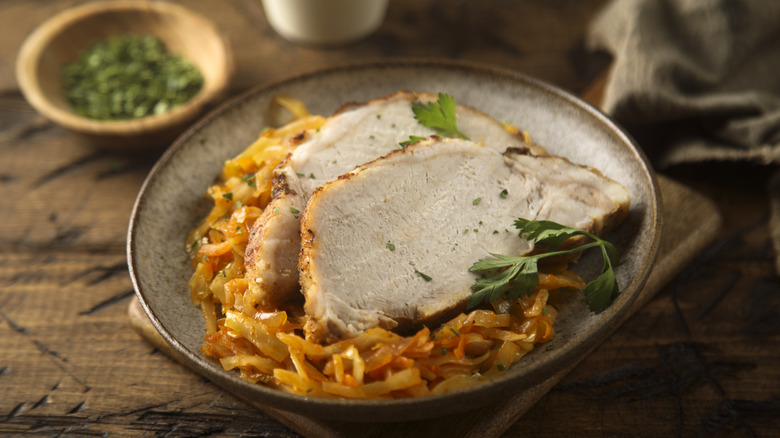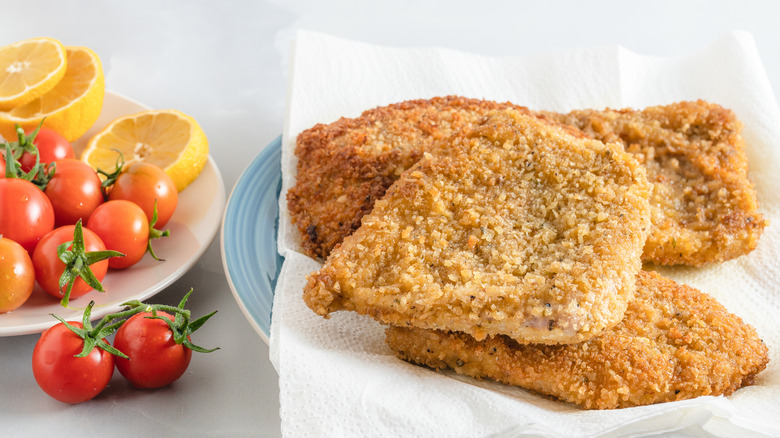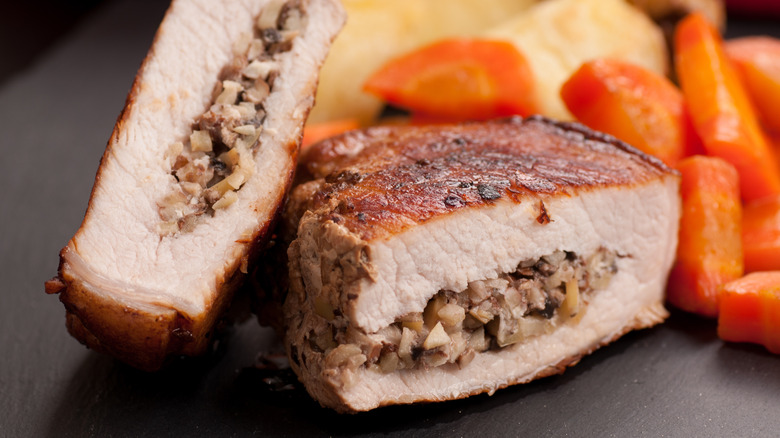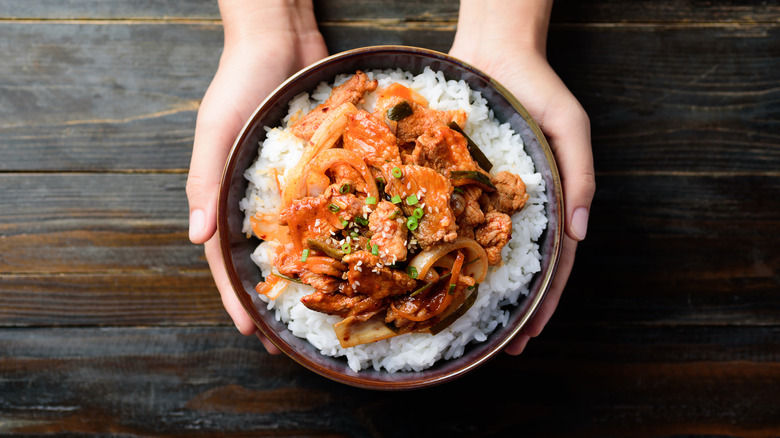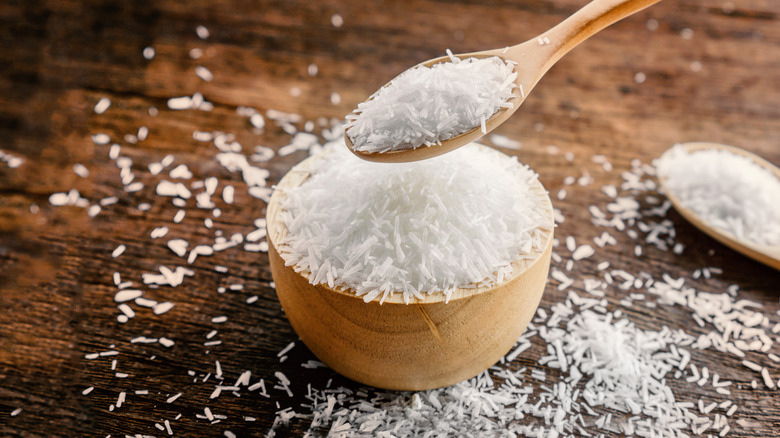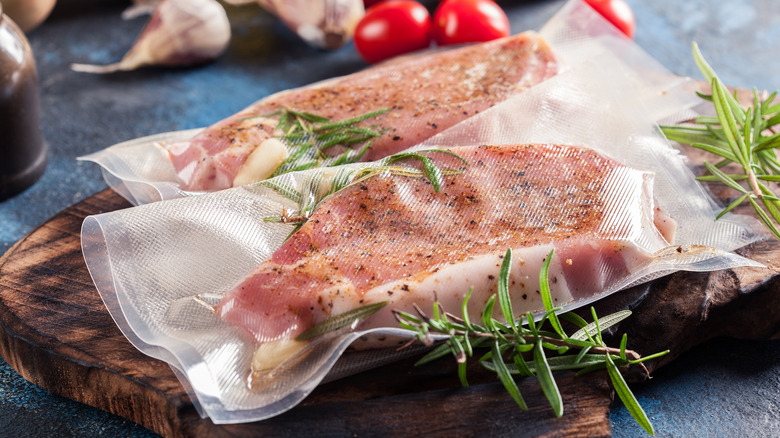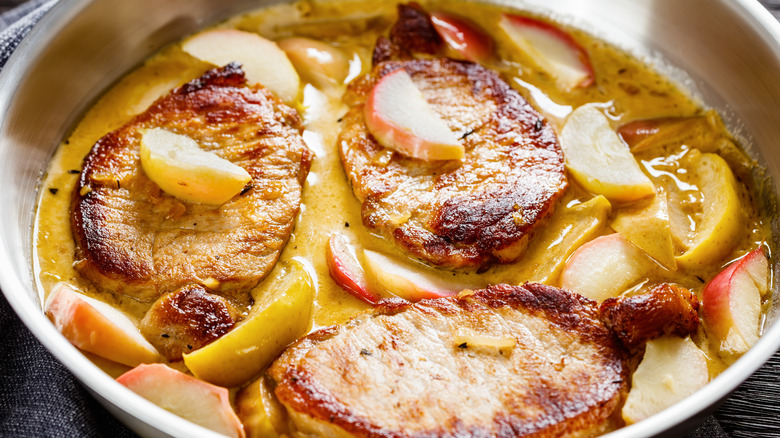12 Ways To Add More Flavor To Pork Chops
Pork chops are convenient weeknight staples. They cook up quickly, they're relatively cheap, and most people seem to like them well enough. But they often fall short of tasting truly awesome. A plain pork chop plopped on a plate isn't anyone's idea of an exciting dinner. If they're not handled right, pork chops have a tendency to be bland, boring and even a little bit dry. At their worst, they're as uninspiring as the dreaded boneless, skinless chicken breast.
We're here to rescue you from your pork chop malaise. This misunderstood cut of meat is a chameleon. With just a little bit of extra effort and some simple techniques, you can change your pork chops from blah to flavor-blasted and make them fit into many different types of meals and flavor profiles from all over the world. There's no reason to ever eat dull pork again. All of these tips are great on their own, and many can be combined to create the ultimate in porky deliciousness.
1. Brine them for several hours
One of the easiest, simplest ways to make your pork chops more flavorful is to brine them. Brining pork chops has the added benefit of increasing the meat's moisture content as well as amping up the flavor.
But what is brining? At its most basic, it's soaking something in a saltwater solution. The salt in a brine partially breaks down the structure of the proteins in a piece of meat and pulls water inside the meat's cells. A piece of meat can gain 10% or more extra water weight during the brining process. More water means more juiciness, so if you find that your pork chops often end up dry, tough, and unappealing, brining will be your best friend.
Although all you technically need for a brine are salt and water, you can use the brining step as an opportunity to add more flavor to your pork than just salt. Our recipe for brined pork chops includes rosemary, mustard seed, coriander, peppercorns, and sugar to help turn a simple pork chop into a flavor explosion. Although a short brine bath can improve a piece of meat a little bit, it takes time for a brine to work its full magic. We recommend at least 8 hours or up to a full day to make that happen.
2. Consider a dry brine
While brining in liquid (or wet brining) is a great technique, it's not for everyone. You may not be a fan of the extra water contained in wet-brined meat. Brining also requires a decent amount of fridge space — enough to hold not just the pork chops themselves, but also sufficient liquid to completely submerge your meat.
Fortunately, there is an alternative to wet brining pork chops that has many of the same benefits (and some argue is even superior): dry brining. To dry brine, you simply add a generous amount of salt (and possibly other seasonings) to the outside of your meat, then keep the meat in the fridge for a day or more before you cook it. Through the magic of osmosis, over time, the salt gets absorbed into the meat, seasoning it all the way through. Here's how it works: The salt initially pulls moisture to the surface of the meat. This dissolves the salt on the surface, and the resulting salty solution then gets pulled back into the muscle fibers.
Dry brined meat doesn't contain extra water, but it retains moisture well during cooking. It tastes well-seasoned and the salt tenderizes the meat as well. Furthermore, since it's dryer than wet-brined meat, dry brined protein browns more quickly.
3. Slather on a marinade
Before we discuss marinating pork chops, we should clear up some common misconceptions about this cooking technique. No, marinades don't tenderize meat. Acidic marinades can make meat soften, but rather than feeling tender, the resulting protein will have an unpleasant mushy texture. Marinades also don't season the interior of a piece of meat (if you want to do that, use a brine). Rather, their effect is limited mostly to the exterior of the food. This means that they have the best effect on thin pieces of meat. The good news is that this makes marinating a great choice for adding flavor to thin-cut pork chops.
While any number of marinades can elevate your pork chops, we have a slightly unorthodox suggestion: Try using soda. Soda is a great meat marinade ingredient because of its combination of sweetness and acidity. Just don't soak your pork chops in straight Coke and expect a delicious result — soda should be mixed with other ingredients and seasonings to make a perfect marinade. Consider using soy sauce to add salty and savory qualities that soda lacks by itself. And don't forget about your meat once it's in the marinade. If you leave meat sitting in soda for too long, the phosphoric acid in the soft drink can cause the mushiness problem we mentioned above.
4. Break out the smoker
Pork chops may not have made it onto our list of the absolute best cuts of meat for smoking, but just about any kind of pork will taste great with a little wood smoke flavor added to it. If you're used to smoking large, tough cuts like pork shoulder or ribs, you will have to take a different approach when you throw pork chops on the smoker. While many barbecue cuts benefit from long, slow smoking at a low temperature to render fat and break down chewy connective tissue, pork chops are usually from more tender parts of the animal and don't need to be cooked for nearly as long.
The benefit of this, of course, is that with pork chops you get to eat delicious barbecue pork much faster than if you have to wait for a pork shoulder to get tender. If your grill/smoker is capable of maintaining multiple heat zones, you can cook your chops on the cool side of the grill until they're smoky enough and then transfer them to the hot side to get them crisp and brown on the outside.
Beyond the smoke, you can season your chops in any number of ways. A simple dry rub is a great way to add extra flavor to smoked pork. Feel free to serve the chops with your favorite barbecue sauce too.
5. Butter baste them
Just about anything tastes better when you add butter to it, and pork chops are no exception. You may be familiar with the butter basting technique from cooking steak, but there's no reason you can't do it with pork chops too.
Start by searing your chops until brown in a hot, oiled pan. Then lower the heat and add several tablespoons of butter. The butter acts as both a flavoring and a cooking medium. You can throw herbs, garlic, and other aromatics into the hot butter to infuse the fat with flavor. At this point, you start basting and turning the pork chops around in the pan, coating them with the infused butter and heating them gently until they're cooked through. The key is to make sure your pan isn't too hot when you add the butter — brown butter tastes delicious, nutty, and savory, but burnt butter tastes acrid and bitter and will ruin the meat you've worked so hard to prepare. If you're able to nail butter basting, your pork chops will have a restaurant-quality polish that's absolutely delectable.
Whether you're keeping things basic or adding some complexity to your dish (consider our pan-seared pork chops with parsnip-apple purée recipe), a buster baste is a surefire way to bring more flavor to the equation.
6. Cook them with sauerkraut
Pork and sauerkraut seems like a very German combination (and it is), but this pairing is also quite popular in the Alsace region of France, which borders Germany and has been ruled by Germany on-and-off throughout history. The Alsatian take on this dish, choucroute garni, is an elaborate affair consisting of several different cuts of pork, sausage, and duck fat stewed together with sauerkraut and potatoes. Though it's delicious and worth the effort for a weekend project, you don't need to clear out your schedule for a whole day in order to enjoy pork and sauerkraut. You can simply cook together some standard supermarket pork chops with sauerkraut in the oven or on the stove for a few minutes, and it'll still be a wonderful weeknight meal. Obviously, it'll be better if you happen to have homemade sauerkraut, but good-quality store-bought stuff tastes great as well.
This combination works so well because the pork and the sauerkraut balance each other out. The acidity and funk from the fermented cabbage cuts through the savory richness of the pork, while the umami and fat from the pork's cooking juices help mellow out the pungency of the kraut.
7. Fry them
You know what they say: When in doubt, deep-fry (we're not sure anyone besides state fair vendors says this, but roll with it). Actually, deep-frying at home can be kind of a pain, so feel free to just shallow-fry in a skillet with a few tablespoons of oil — you'll still get deliciously, crispy breading and juicy meat.
The great thing about this method, besides the fact that all fried food tastes amazing, is that you can tweak your ingredients to make different dishes with very different flavor profiles. For example, you can bread your chops in fresh breadcrumbs, fry them in olive oil and butter, and garnish them with arugula and Parmesan to make Italian pork chops alla Milanese. Or you could mix shredded coconut into your breading mixture to make a tropical spin on fried pork chops. And if that's not your style, you can always bread and fry your pork chops as you would for fried chicken and serve them on Texas toast with Duke's mayo for down-home Southern-style pork chop sandwiches.
8. Stuff them
We think it's a shame that many people only eat stuffing once a year at Thanksgiving. Stuffing tastes good 365 days a year, so why not throw it into your normal dinner rotation every once in a while? You don't have to cook a 20-pound bird just to enjoy this old-fashioned treat.
Compared to a stuffed turkey, stuffed pork chops are quick and easy to make. Simply butterfly your pork chops and open them up like books, being careful not to cut all the way through them. Add as much of your favorite stuffing as will fit, close them back up, and cook them. To help prevent stuffing from leaking everywhere, it's helpful to close the cut side of the chops with toothpicks or skewers — just remember to remove them once the pork chops are done so none of your guests gets a sharp surprise. As for what stuffing to use, let your imagination run wild. Classic Thanksgiving stuffing (even the boxed kind) is wonderful, as are more niche options like oyster stuffing, wild rice stuffing, or even mixtures that incorporate dried fruit.
Stuffing a pork chop turns it into a thick cut of meat, so the oven is a good cooking method to use to make sure your stuffed chops cook all the way through. It's a very good idea to check the temperature of the stuffing with a meat thermometer to make sure it's safe before you serve your chops.
9. Stir-fry them with flavorful ingredients
You may be inclined to keep things simple and cook your pork chops whole. But what if you think outside the box and slice your chops into thin, bite-size slivers? Then your pork has a whole lot more surface area to soak up delicious seasonings and sauces. Thinly-sliced pork chops are great candidates for stir-frying.
Our spicy stir-fried pork recipe comes together in a snap. The most time-consuming part is prepping the pork. After it's sliced, you mix it with flavorful marinade ingredients like chile-garlic paste, soy sauce, and garlic and let it absorb those flavors for an hour. After that, stir-frying it with scallions in a hot skillet takes only a couple of minutes. Once again, you don't have to use our specific recipe; just think of it as a road map for a particular cooking technique. You could do the same thing with teriyaki flavors, or bulgogi, or stir-fry the pork with Sichuan peppercorns and dried chiles to take it in a Chinese-inspired direction.
10. Use MSG
If you're looking for an instant hack that will supercharge your pork chops, we have an option for you: Season them with monosodium glutamate, commonly known as MSG. Those of you who have been brought up to believe that MSG is some terrifying mystery chemical that will make you sick can relax. Per FiveThirtyEight, the health concerns about it are overblown, and you can buy it in any normal grocery store under the brand name Accent. (Accent sounds a lot less scary than monosodium glutamate, doesn't it?)
Embracing MSG in your cooking will reward you with wildly tasty pork chops as well. MSG is basically the pure distilled taste of umami, the flavor that makes meat (and many other foods) taste savory and craveable. MSG-seasoned pork chops will simply taste like yummy pork, except their flavor will be heightened and made more delicious in a subtle way. Just don't use MSG as the only seasoning on the meat. Instead, incorporate it into a rub with salt and whatever other spices you like.
11. Give them a sous vide bath
This method is rather time-consuming, but most of that time is unattended, and it's an almost foolproof way to produce flavorful, juicy pork chops that turn out the same every single time. The term "sous vide" refers to cooking foods in a vacuum-sealed plastic bag. You usually put the bag in a circulating container of water that's held at a very specific temperature and let the food very gently warm up to the same temperature as the water. In our sous vide pork chop recipe, the pork cooks in a 140-degree Fahrenheit bath for an hour. Since the sous vide machine controls the water temperature, there's no chance for the pork chops to overcook.
But where does the extra flavor come in? That happens during the vacuum-sealing stage. This method gives you an opportunity to seal aromatics in with the pork very tightly inside the vacuum bag. As the pork cooks, the aromatics will perfume the meat.
The main drawback of sous vide cooking is that it produces pale, wet food with no browning and very little texture. Fortunately, you can quickly and easily remedy that by browning your chops in some oil in a skillet after their sous vide bath. Just remember that they're already cooked, so don't sear them for too long or they might overcook.
12. Cook them with fruit
It's no secret that pork plays well with sweet flavors. Just think of honey-glazed ham, or maple bacon, or ribs slathered in molassesy barbecue sauce. Pork and fruit are natural friends, with the fruit lending sweetness and also (depending on what kind you use) some acidity.
You can combine pork chops and fruit in innumerable ways. We already mentioned stuffing them with dried fruit. Baking them with sliced apples is another easy way to pull off this trick. You can also glaze them with a variety of different fruit juices. Pineapple and orange juice are especially delicious when used this way.
Even if you don't commit to cooking your pork chops with fruit, you can add fruit-based condiments at the table to spice things up. A nice fruit chutney adds a ton of complexity to a plain pork chop, bringing some sourness, sweetness, and often a little bit of heat to the party.
